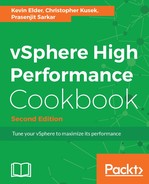In vSphere 6.x, there are four types of SCSI controllers for a VM. They are:
- BusLogic Parallel
- LSI Logic Parallel
- LSI Logic SAS
- VMware Paravirtual
In order to successfully boot a VM, the guest OS must support the type of SCSI HBA you choose for your VM hardware.
BusLogic Parallel is there to support your old Guest OS; an example is Microsoft Windows 2000 Server.
LSI Logic Parallel is there to support most guest operating systems. There is not much difference in I/O performance between Bus Logic and LSI Logic; however, there is a slight difference in the way the hardware represents itself inside the guest. VMware recommends picking up LSI Logic for your Linux.
LSI Logic SAS has been built to support even newer Guest Operating Systems with advanced feature support, for example, clustering support in Windows 2008 and newer. As it is a specially built controller, it boosts the I/O performance slightly than your legacy controller. You need to use VM hardware version 7 and above to get the ability to use it.
VMware Paravirtual is VMware's virtualization-aware controller for high-performing VMs. It is built to reduce CPU overhead while still increasing I/O throughput. This driver coalesces interrupts to reduce the amount of CPU processing required.
This controller also requires hardware version 7 and above. As a best practice, you can still use a default controller for the OS to come up, and for the high I/O load VM, you can use the VMware Paravirtual controller for the data disk. In this way, operational complexity is reduced.
In some cases, large I/O requests issued by applications in a VM can be split by the guest storage driver. Changing the guest operating system's registry settings to issue larger block sizes can eliminate this splitting, thus enhancing performance.
